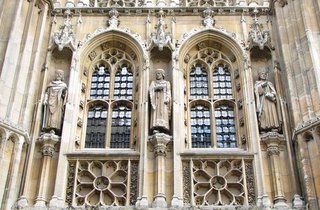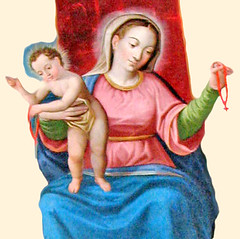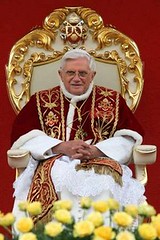Studies in medieval Cambridge
 I am currently reading a book called 'Catholic Cambridge' by M.N.L. Couve de Murville, the former Archbishop of Birmingham, and Philip Jenkins, which was published by the Catholic Truth Society in 1983. It is a fascinating book and excellently researched and it helps explain many of the traditions and pre-Reformation roots of Cambridge University and its famous collegiate system. Those among you who read my talk about Blessed Jordan of Saxony may well wonder (as I did) what his education was like. This book elucidates what it was like to study in a medieval university and the kind of scholastic education a friar might have undergone. I am indebted to the authors of that book for much of what follows in this post.
I am currently reading a book called 'Catholic Cambridge' by M.N.L. Couve de Murville, the former Archbishop of Birmingham, and Philip Jenkins, which was published by the Catholic Truth Society in 1983. It is a fascinating book and excellently researched and it helps explain many of the traditions and pre-Reformation roots of Cambridge University and its famous collegiate system. Those among you who read my talk about Blessed Jordan of Saxony may well wonder (as I did) what his education was like. This book elucidates what it was like to study in a medieval university and the kind of scholastic education a friar might have undergone. I am indebted to the authors of that book for much of what follows in this post.The university in Cambridge dates back to 1209 at the latest. In fact, this date marks the first mention of scholars in this town. It ought to be remarked that all scholars were, at that time, clerics and in that year, there was a dispute between scholars and the town in Oxford, involving the murder of a townswoman. The mayor of Oxford arrested three students responsible for the crime and, with the king's permission, hanged them. This caused an uproar as the Church demanded a right for its clerics to be tried by ecclesiastical courts and to be free from secular interference. As a result a reported 3000 scholars left Oxford and went to Cambridge and Reading.
Why Cambridge? Possibly because this ancient Roman town was already then a thriving town with plenty of coming and going and a surplus of lodgings for the students. More importantly, it was free of immediate control by a lay or ecclesiastical magnate. There may also have been a positive influence from the bishop of (nearby) Ely which encouraged the scholars to settle here.
Universities in the early Middle Ages were well adapted to this kind of migration because they did not own property; masters and students lived in rented lodgings and the teaching was done in rented premises as well. In addition, the medieval university was an ecclesiastical body and the Chancellor received his authority from the Bishop of Ely. As such, until 1856 (although it fell into abeyance in the 18th century), the Chancellor of Cambridge University could issue excommunications and imprison delinquents! It was only in 1430 that Cambridge secured independence from the local bishop with the Pope's permission, thus confirming its status as a studium generale whose masters had an ius ubique docendi, right to teach everywhere.

A rather unusual feature of the Cambridge undergraduate degree is that there is no B.Sc at Cambridge; whether one studies an arts or a science subject for his first degree, he obtains a B.A. at the end of the course. The origin of this terminology goes back to the Middle Ages when the basic course of study in all universities was called the course in arts because of the early medieval scheme of the seven arts into which all non-theological study was divided: grammar, rhetoric, logic, arithmetic, music, geometry, astronomy.
Medieval arts students started their university courses at the age of 14 or 15 and were expected to come equipped with Latin. The arts course was spread over 7 years and the students studied the books (the basic author being Aristotle) with the help of lectures given by the Masters or Bachelors. As books were at a premium, the Masters and Bachelors went through the text sentence by sentence, reading them to the students and expounding its meaning and the arguments of the author as he went along.
Once the student had a good grounding, he had to acquire the art of rational argument. The disputatio was the characteristic exercise of the medieval university. This was a debate, in which one student argued for a proposition and another argued against it. A Bachelor or Master presided and would, in due course, determine the question and give his solution. No one could determine until he had been a student for four years and had been accepted by a Master as a Bachelor.
This in effect made him an associate student and even as he carried on with the remaining three years of his studies he taught the basics to other students and acquired yet more experience in disputations.
When these three years were over he could incept, ie, begin his career as a Master of Arts. In the Middle Ages, to become an accredited university teacher was to assume the regimen, rule of scholars; the teaching Masters were hence called regent Masters, from which Regent House, the assembly of teaching members of Cambridge University, gets its name.
Only now could the Master of Arts go on to study theology, if he so desired. The theology course was taught by Bachelors and Masters and the standard text was the Sentences of Peter Lombard (c.1095-1160). The 13th century saw the birth of systematic theology which was an attempt to study theology with the light of reason guided by faith. It was a Master's privilege and duty to read, analyse and comment on the Scriptures in depth. Bachelors also had to read the Bible cursorily as an apprenticeship.
Once the Sentences had been read, the basic form of teaching was once again, the disputation. Bachelors were the respondents and at which a Master presided. An opinion was enunciated; objections to it were brought forward one by one and answered systematically. The method was extremely dialectic and readers who are familiar with the Summa Theologiae of St Thomas Aquinas would recognize the style immediately. After the disputation by the Bachelors, the Master would determine the question by giving his solution. Many of these were published under the title of Questiones disputatae. Another form of disputation was the quodlibet, a free-for-all held in Advent and Lent at which the Master of Theology himself would be the respondent and take on all comers in argument. This must have been a fascinating exercise, an intellectual tournament!
The course in theology was a long one. If the theological student had been a regent Master of Arts, he could begin to oppose in a disputation in his fifth year. If not, he had to wait until his seventh year! In the seventh year after his regency in arts, he was allowed to read the Sentences with students and to become a Bachelor of Theology.
The Master of Theology was conferred on those who had been regent Master in Arts, who had attended lectures in theology for 10 years including 2 years of lectures on the Bible, who had read for students all the books of the Sentences and some book of the Bible, who had been opponent and respondent in the theology faculty after reading the Sentences and who had preached publicly to the clergy. So it took 18 years for an M.A. (which took at least 7 years) to become Master of Theology; for a friar it was 20 years!!

The Master of Theology (later called a Doctorate in Divinity) was the highest distinction in the academic world then and it was obtainable only at Paris, Oxford and Cambridge in the 13th century and for much of the 14th century. Small wonder that the early Dominicans made a bee-line for these centres of learning.
Another title for the Master of Theology was Magister in sacra pagina, the Master of the sacred page, so that the ability to expound the Scriptures was considered as the highest achievement of the theologian. And to think, it only takes a few years now to receive a Master in Theology! How splendidly learned were these men and how skilled they must have been in discourse and disputations...
To be continued... Next: The Friars in Cambridge
Illustrations above are of St John Fisher delivering a lecture in Cambridge. He was Chancellor of Cambridge University in 1504 and again from 1514 until his martyrdom in 1535. The window is from Our Lady and the English Martyrs Church, Cambridge; Aristotle and Plato by Raphael; St Thomas Aquinas teaching or preaching; Statues on the facade of a University building which depict characters associated with the medieval university.







1 Comments:
Yeah, yeah, so basically all the good stuff in Cambridge is derived from Oxford...
:-)
Post a Comment
<< Home